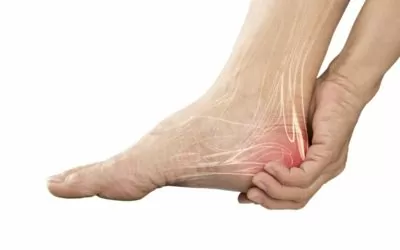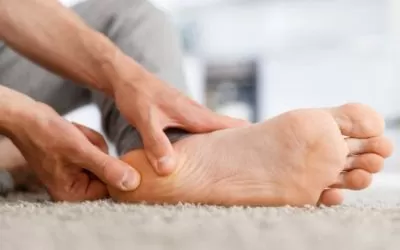Diagnostic Foot Ultrasound
At the Sussex Foot Centre, we have recently invested in an Ultrasound Machine so that we can continue to offer the very best and most innovative services in Podiatric care for our patients. We are one of only a few podiatrists in Sussex to provide this service. We believe that diagnostic ultrasound is essential for ensuring patients receive effective treatment as quickly as possible.
Our new machine has made a huge difference to the effectiveness of the treatments we provide. It has helped us to identify a wide range of foot and ankle problems which would have otherwise been nearly impossible to diagnose.
Book Your Diagnostic Ultrasound Appointment for £60.00 (includes Podiatry Consultation)
What is Diagnostic Ultrasound?
Ultrasound is an imaging method which uses high-frequency sound waves to accurately produce images of structures within the body. It is most commonly used when viewing a foetus during pregnancy, but it is also used throughout medicine to investigate and identify a wide variety of diseases and conditions.
It is also sometimes referred to as a ‘Musculoskeletal Ultrasound’, which simply means that it produces pictures of muscles, tendons, ligaments, and joints within particular areas of the body. It is an imaging technique that is particularly useful when identifying lower limb-related conditions, such as:
- Achilles tendonitis
- Plantar fasciitis
- Heel spurs
- Torn tendons
- Ligament injuries
- Stress fractures
- Morton’s Neuroma
- Tarsal tunnel syndrome
- Foot or ankle-based Arthritis
- Bursitis or capsulitis
Ultrasound Guided Injection to Foot
Once a Musculoskeletal Ultrasound has pinpointed a specific issue, a foot ultrasound-guided injection will often be used to ensure that treatments are accurately administered. Using our ultrasound equipment, we can guide injections of cortisone to the exact location that’s causing pain, helping to ensure the effectiveness of our treatments.
What are the main reasons to get a diagnostic foot ultrasound?
Ultrasounds are performed for a variety of reasons, from minor issues, such as pain and discomfort, to more serious problems, like tumours and cancers. An ultrasound scan of the foot can help identify a number of issues. They can even spot arthritis in the foot and ankle, due to the swelling and inflammation that the condition causes.
Here are a few other problems that foot scans can help detect:
- Tears
- Discomfort
- Pain
- Inflammation
See more
- Reduced Movement
- Tendonitis
- Plantar Fasciitis
- Plantar Fibromatosis
- Plantar Fibroma
- Arthritis
- Morton’s Neuroma
- Tumours and Cancers
What happens during a diagnostic foot ultrasound?
Before the Ultrasound imaging takes place, you will likely be asked to remove jewellery or clothing from the area being examined. A small amount of jelly-like gel will then be applied to the area causing you pain. This gel is designed to prevent air pockets, which often interfere with the sound waves that are used when developing the images.
Next, a small hand-held device will be moved across the affected area, capturing the picture simply and painlessly. This image will then show on the ultrasound monitor, allowing you to see the inner workings of your lower limb issue in real time. At the end of the examination, a member of our team will explain what they found, and talk through any next steps in more detail.
Each test takes around 10 – 15 minutes and is completely pain-free, so there’s no need to worry at all.
If you are struggling with a lower limb issue but are unsure what it is or how to treat it, an ultrasound could make all the difference. To arrange an appointment, please call our experienced team on 01444 453874, or click here.
Are diagnostic foot ultrasounds painful?
Not at all! Ultrasounds are one of the safest types of imaging procedures. The process requires minimal patient preparation and has no known risks. It might give you a slightly odd, tickly sensation, but it’s perfectly harmless. Plus, after your issue has been diagnosed, we can work with you on getting it treated effectively.
What are the benefits of diagnostic ultrasound vs. MRI and CT scans?
Ultrasounds are the cheapest, easiest and quickest imaging solutions. CT (Computerised Tomography) scans and MRI (Magnetic Resonance Imaging) scans may offer slightly higher quality and better-detailed images, but they are a lot less available and more invasive than using an ultrasound.
Plus, since images are captured in real-time during an ultrasound, they can show the movement of the body’s internal organs and blood vessels. MRI scans tend to be a better choice when detecting cancerous growths and tumours, whereas CT scans are typically more widely used to take detailed images of the brain.
Achilles Tendon Pain
The Achilles Tendon which Is also named the Calcaneal Tendon is avery durable, strong band of tissue. It connects the calf muscles tothe heel bone, and it is the strongest tendon in the human body, capable of holding up to 3 times its body...
Plantar Fasciitis: What is it?
Plantar Fasciitis is a common condition treated at The Sussex Foot Centre. ThePlantar Fascia is a large band of tissue which is situated along the bottom ofthe foot. Medical research states that Plantar Fasciitis affects up to 10% of thepopulation. It is therefore...
Calling All Runners
Calling all runners, we want to hear from you! If you are experiencing any aches and pains during or after your run, we would love to talk to you and discuss exactly how we can help. For a limited period of time, we will be...
BOOK AN APPOINTMENT
Follow the form below to get through directly to one of our Podiatrists at the practice or to request an appointment.
Or call — 01444 453874
"*" indicates required fields



